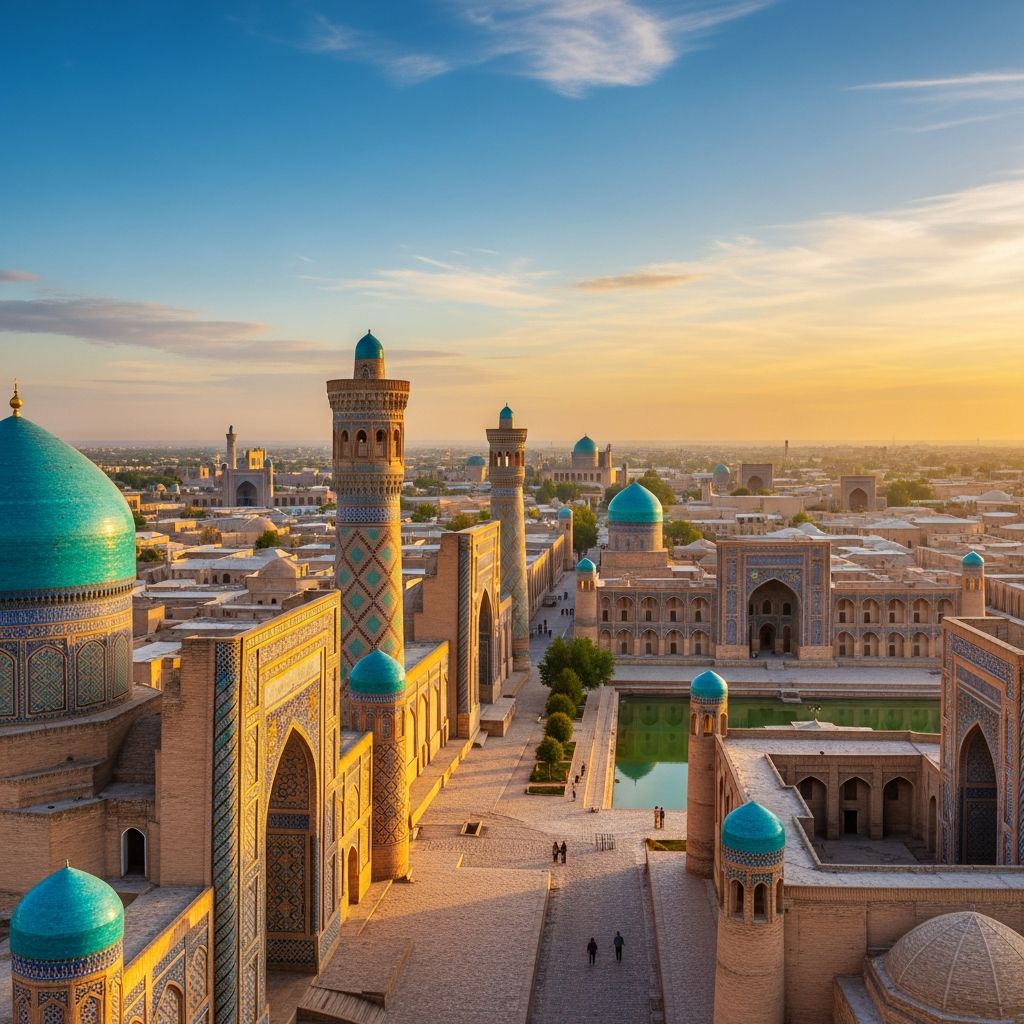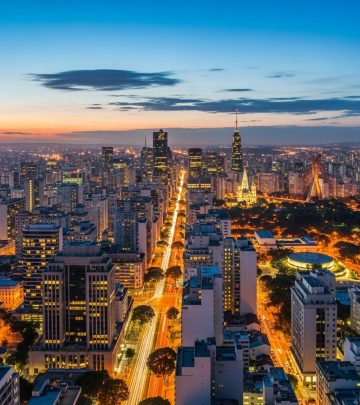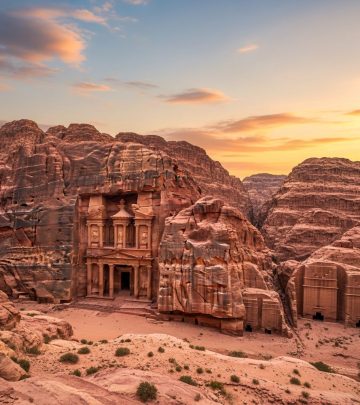Bukhara: Heart of the Silk Road and Central Asia’s Holiest City
Explore Bukhara, a vibrant crossroads of history, faith, and Silk Road grandeur in Central Uzbekistan.

Bukhara: A Living Silk Road Legend
Bukhara, known in Uzbek as Buxoro, stands as Central Asia’s holiest city and an essential stop along the legendary Silk Road. Its atmospheric old center, remarkably preserved, brings to life a thousand years of Islamic architecture, scholarship, and commerce. Walking through Bukhara means treading the same paths as caravan traders, Sufi mystics, and powerful khans, in a city whose sacred and commercial legacy remains vivid to this day.
Bukhara seamlessly blends its spiritual essence with daily vibrancy; leafy plazas and bustling markets evoke centuries of gathering, reflection, and trade. Despite growing tourism, Bukhara maintains an authenticity and depth unrivaled in the region, offering a feast for the senses and the spirit alike.
Why Visit Bukhara?
- A Historic Heartbeat: Experience a city with architecture spanning over a millennium and an ambience largely unchanged over the past two hundred years.
- Spiritual Significance: Bukhara is famed as the holiest city in Central Asia, a center for Islamic scholarship and Sufism.
- Silk Road Heritage: Once a critical Silk Road outpost, Bukhara’s domed bazaars, caravanserais, and trading domes evoke the clamor and culture of ancient commerce.
- Cultural Immersion: Discover an unexpectedly lived-in city, where tradition thrives amid the old city walls.
Main Sights in Bukhara
Bukhara’s compact old town gathers some of the continent’s finest Islamic monuments around tranquil plazas, endlessly walkable alleys, and markets alive with local crafts.
The Ark Fortress
The Ark is a towering, mud-brick fortress that was home to Bukhara’s emirs for centuries. This imposing citadel, with foundations dating from the 5th century, houses intriguing museums and offers commanding views over the historic city. Its thick walls withstood invasions and intrigue, and today, visitors can wander its halls to discover exhibitions on royal life, Central Asian history, and the sometimes-turbulent legacy of Bukhara’s rulers.
Kalon Minaret and Mosque
- Kalon Minaret: Standing 47 meters high, this soaring 12th-century minaret is Bukhara’s architectural icon. Nicknamed the “Tower of Death” for its grim history, the minaret survived Mongol destruction and attracts visitors for sunsets that illuminate its intricate brickwork.
- Kalon Mosque: The city’s spiritual core, this vast 16th-century mosque holds up to 10,000 worshippers at once. Its calm courtyard, echoing blue domes, and arcaded halls make it a masterpiece of Central Asian architecture.
Mir-i-Arab Madrasah
Set opposite the Kalon Mosque, the Mir-i-Arab Madrasah is renowned for its vibrant blue dome and stunning tilework. Built in the 16th century, it remains a functioning religious school, symbolizing Bukhara’s legacy as an intellectual center. Though tourists can’t enter its interior, the facade and courtyard glimpses are mesmerizing.
Lyabi-Hauz
The leafy Lyabi-Hauz plaza, centered on a cool, tree-lined pool, forms the social heart of old Bukhara. Surrounded by cafes, teahouses, and madrasahs, this oasis is a prime spot for relaxation, people-watching, and soaking in the city’s enduring energy. The area’s mosaic-adorned monuments set a serene and photogenic backdrop at any hour of day.
Char Minar
This quirky monument, whose name means “Four Minarets,” is an unusual 19th-century gateway topped with four blue-domed towers. Set among neighborhood lanes, it’s a magnet for photographers and a symbol of Bukhara’s old-world charm.
Maghok-i-Attar
Considered one of the region’s oldest mosques, Maghok-i-Attar is notable for its sunken floor—legend says it was built on the foundations of a Zoroastrian temple. Now a carpet museum, its brickwork and historical layers offer insight into pre-Islamic and Islamic Bukhara alike.
Ismail Samani Mausoleum
Dating to the 10th century, the Ismail Samani Mausoleum is Bukhara’s most architecturally significant ancient monument. This family tomb, with walls built from honey-colored bricks laid in mesmerizing geometric patterns, glimmers under the sun and is revered as a pinnacle of early Islamic architecture in Central Asia.
Nadir Divan Begi Madrasah and Khanaka
The Nadir Divan Begi complex features an ornate madrasah and its adjacent khanaka (Sufi lodge). The madrasah is famous for peacock and sun motifs rarely seen in Islamic art, while the khanaka houses a museum and occasional performances, providing a lively scene for both history and culture lovers.
Experiencing Modern Bukhara
Daily life in Bukhara pulses through thrumming bazaars and tranquil plazas. Join locals under the shade at Lyabi-Hauz, browse mosaiced trading domes packed with carpets, ceramics, and local oddities, and pause at teahouses for plov or shakarob tomato salad. Despite restoration and tourism, much of Bukhara’s spirit remains undimmed, inviting every visitor to savor both spectacle and serenity.
- Markets & Trading Domes: Roam the Toki-Zargaron (jewellers’ dome), Toki-Sarrafon (moneychangers’ dome), and Toki-Telpakfurushon (cap-makers’ dome)—lively reminders of Bukhara’s days as Silk Road crossroad.
- Workshops: Visit family-owned shops with exquisite embroidery, scissors shaped like storks, hand-woven carpets, and hand-crafted knives.
- Cafes & Dining: Old Bukhara Restaurant and Chalet offer shaded terraces and local cuisine—don’t miss the baklava or the local salads.
Visiting Practicalities
Getting There
- By Train: Bukhara connects by modern rail to Samarkand and Tashkent, with fast trains taking roughly four hours from the capital.
- By Road: The overland journey from Khiva or Samarkand travels across the Kyzylkum Desert into Bukhara, offering glimpses of rolling sands and strategic rest stops.
Where to Stay
- Central Options: Historic center hotels such as Hotel Shahriston and Lyabi Haus Hotel are walkable to top sites, with tree-shaded courtyards and hearty breakfasts.
- Authentic Guesthouses: Many restored madrasahs now host travelers craving a blend of tradition and comfort.
When to Visit
- Spring (April–June) and Autumn (September–October): These are prime seasons, when temperatures are pleasant and market life is buzzing.
- Winter: While quieter, Bukhara’s monuments look spectacular under a dusting of snow.
Suggested Itineraries
Bukhara is best experienced over two or more days:
- Day One: Explore the Ark, Kalon Minaret and Mosque, Mir-i-Arab Madrasah, and Lyabi-Hauz. Take time for shopping and sunset at the Kalon complex.
- Day Two: Visit Maghok-i-Attar Mosque and carpet museum, walk through the trading domes, see Nadir Divan Begi Madrasah, and relax in a local hammam.
- Extend: Visit Ismail Samani Mausoleum, Chashma-Ayub Mausoleum, Char Minar, and take a ceramics masterclass in a caravanserai workshop.
Top Experiences in Bukhara
| Attraction | Highlights |
|---|---|
| The Ark Fortress | Ancient citadel, museums, panoramic city views |
| Kalon Minaret & Mosque | Iconic minaret, vast prayer hall, tiled domes |
| Mir-i-Arab Madrasah | Blue domes, ornate tilework, active religious school |
| Lyabi-Hauz | Atmospheric plaza, cafes, social hub |
| Ismail Samani Mausoleum | 10th-century tomb, geometric brickwork, UNESCO-listed |
| Nadir Divan Begi Complex | Sufi lodge, peacock tiles, cultural performances |
| Trading Domes | Bazaars, crafts, centuries-old commercial heritage |
| Maghok-i-Attar Mosque | Oldest mosque, carpet museum, archaeological layers |
| Char Minar | Quirky gatehouse, four blue domes, photogenic |
The Spirit of Bukhara: Living History
Bukhara is one of the best places in Central Asia for an authentic glimpse of pre-Russian Turkestan. Its old city is not just a museum but a living community where artisans ply trades, imams chant calls to prayer from centuries-old minarets, and elderly men gather under mulberry trees for tea and conversation.Local tradition and hospitality run deep—join a cooking class to learn plov (Uzbek pilaf), spend an afternoon in a working hammam, or take in a cultural show at Nadir Divan Begi. Keep an eye out for regional costumes, bustling family workshops, and the intricate tilework and brickwork that make even hidden lanes a feast for the eyes.
Getting Around Bukhara
- On Foot: The historic core is walkable, allowing you to linger at every madrasah and market.
- Taxi: For attractions outside the core (such as the Ismail Samani Mausoleum), local taxis are easy to hail.
- Bikes: Some guesthouses offer bicycles, a breezy way to traverse broader boulevards in the modern district.
Suggested Side Trips
- Chashma-Ayub Mausoleum: Visit this unique shrine said to once have been blessed with a spring by the prophet Job; locals believe its waters have healing powers.
- Gijduvan: A town nearby famous for its ancient ceramic workshops, perfect for a short day trip for those keen to explore rural Uzbek craftsmanship.
Frequently Asked Questions (FAQs)
Q: What is the best time to visit Bukhara?
A: The ideal travel seasons are spring (April–June) and autumn (September–October) for mild temperatures and lively street life.
Q: How many days should I spend in Bukhara?
A: 2–3 days are ideal to explore major sights, markets, and absorb the city’s history and charm.
Q: Is Bukhara suitable for independent travelers?
A: Yes, the city’s historic center is safe, compact, and easy to navigate on your own, though guided tours add depth for history enthusiasts.
Q: What traditional foods should I try?
A: Don’t miss plov (Uzbek pilaf), shakarob salad, walnut baklava, and local breads. Many cafes and restaurants serve cuisine from across Uzbekistan.
Q: Are English speakers common in Bukhara?
A: Many staff at hotels, restaurants, and main tourist attractions speak basic English, and signage in the old town is increasingly visitor-friendly.
Travel Tips for Bukhara
- Dress Code: Modest clothing is advised when visiting mosques, madrasahs, and older neighborhoods.
- Photography: Most historic sites permit photography, but ask permission before photographing locals.
- Shopping: Bargain politely at markets. Hand-embroidered suzanis, ceramics, and silk scarves make memorable souvenirs.
- Connections: Bukhara links by train to Tashkent, Samarkand, and Khiva, forming the classic Uzbekistan circuit.
Conclusion
Bukhara is no ordinary destination—it is a city that gathers up the threads of a thousand years and weaves them into a tapestry of living heritage, spiritual grace, and timeless hospitality. Every archway, bazaar, and shaded plaza beckons with stories, inviting travelers to linger, learn, and be enchanted.












